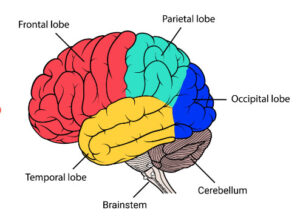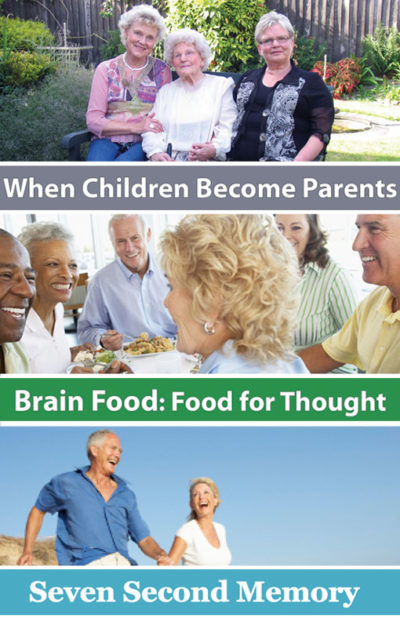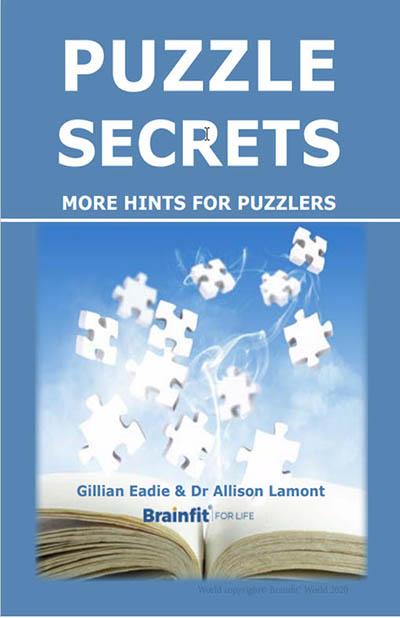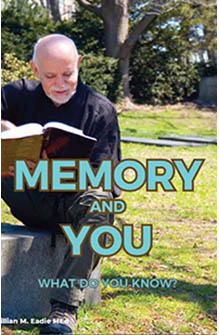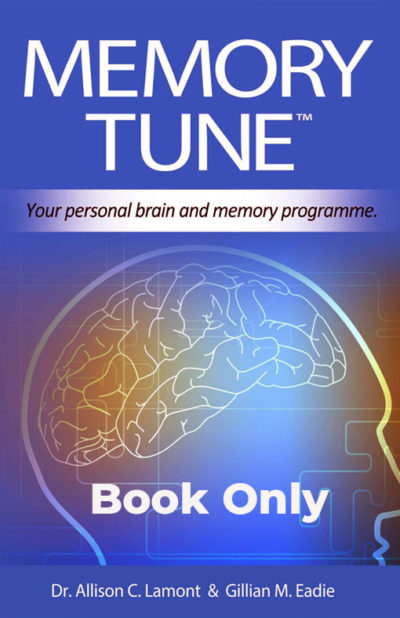|
Hippocampus
The hippocampus, Latin for seahorse, is named for its shape. The hippocampus plays a vital role in the formation of new memories. It is near the centre of the brain and is part of a system that directs many bodily functions – the limbic system. There are two interlocking hippocampi with one hippocampus extending into each temporal lobe. At the front end of each hippocampus is a small almond-shaped amygdala which works closely with the hippocampus in processing the emotional content of memories.
Functions of the Hippocampus
- Formation of new memories
- Learning and storing information about spatial navigation and spatial memory such as pathways or routes
- Especially important in declarative memories, which are related to facts and events. Learning how to memorize speeches, remembering a story or telephone numbers are good examples of declarative memory.
- Coordinating new and old memories together.
- The vital link for turning short-term memories into long-term memories which are then stored elsewhere in the brain.
- The hippocampus is one of the few places in the brain where new brain cells are generated.
Symptoms associated with Hippocampal Damage
- Because of its vital role in memory, damage to the hippocampus can result in a strange world of new experiences, as there will be an inability to remember events or experiences as they occur.
- The hippocampus deals with the formation of long-term memories and spatial navigation. Because it is one of the first regions of the brain to become damaged in diseases such as Alzheimer’s disease, this leads to the memory loss and disorientation associated with the condition.
- Damage to the hippocampus can cause hyperactivity and affect the ability to inhibit responses that have previously been learnt. It will be difficult to ‘unlearn’ old habits.
- The hippocampus can become damaged through oxygen deprivation or hypoxia, infection, inflammation, or as a result of temporal lobe epilepsy.
|
|
Frontal Lobes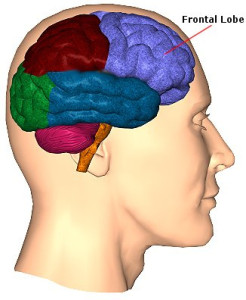
The frontal lobes are part of the Cerebral Cortex and are the largest of the brain’s structures and contain a number of important substructures, including the prefrontal cortex, orbitofrontal cortex, motor and pre-motor cortices, and Broca’s area. They control the ‘higher’ cognitive functions (attention and conscious thought, voluntary movement, decision–making, and language); they determine personality and contain the motor cortex that controls movement of the muscles of the body (the motor cortex on the right half of the brain controls the left side of the body and vice versa).
Functions of the Frontal Lobes
- Executive functioning such as planning, working memory, attention, problem-solving, verbal reasoning, inhibition, mental flexibility, multi-tasking, initiation and monitoring of actions.
- Emotional response and stability.
- Personality
- Judgement
- Word meanings
- Memory for habits
Symptoms associated with head Injury or a tumour in the Frontal Lobes may include:
- Difficulty in planning sequences such as in making a cup of coffee
- Apathy and loss of interest in life, lack of spontaneity when interacting with others
- Loss of thinking flexibility (mental rigidity)
- Difficulty focusing. Lack of attention
- Personality changes
- Difficulty planning or organizing
- Difficulty speaking
- Often repeating actions many times without awareness of doing so
- Mood swings and loss of inhibition(may lead to offensive behaviour which is out of character for that person e.g. swearing, rudeness, inappropriate sexual behaviour
- Weakness of one side of the face or body
- Problems walking
- Disorders of the Frontal Lobes may include ADHD, schizophrenia, and bipolar disorder (prefrontal cortex).
|
|
Parietal Lobes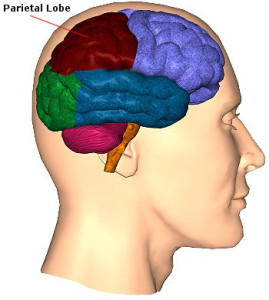
The parietal cortex integrates information from different senses to build a coherent picture of the world. e.g. from the Ventral visual pathways (which process what things are) and Dorsal visual pathways (which process where things are), we coordinate movements in response to objects in our environment. This helps us understand space and distance, size, texture and weight. These are constantly being updated as we move and interact with the world around us.
Functions of the Parietal Lobes
- Visual perception
- Touch perception
- Manipulating objects
- Integrates information from the senses into one single concept – including pain, pressure, and temperature
- Goal-directed voluntary movement
- Spatial sense and navigation
- Knowledge of numbers and their relation to one another
- Responsive to shape, size, and orientation of objects
Symptoms associated with head Injury or tumours in the Parietal Lobes may include:
- Anomia – difficulty naming objects
- Difficulty speaking or understanding speech
- Unable to focus visual attention
- Problems reading and writing (agraphia)
- Unable to focus on more than one object at a time
- Poor hand-eye coordination
- Difficulty with simple maths problems
- Difficulty drawing
- Confusing left and right
- Visual perception poor
- Loss of sensation in part of the body
- Self-care compromised because of lack of awareness of some body parts and surrounding space (Apraxia)
|
|
Occipital Lobes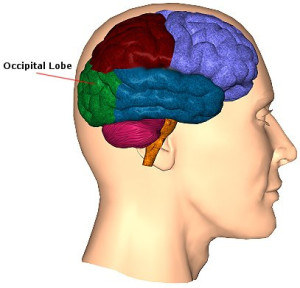
The occipital cortex is the primary visual area of the brain, receiving information from the retina (via the thalamus). Pathways from the occipital lobes reach the Temporal and Parietal Lobes and are eventually processed consciously.
Functions of the Occipital Lobes
- Visual perception
- Colour discrimination
- Movement perception
- Creation of dreams
Symptoms associated with head injury or tumours affecting the Occipital Lobes
- Difficulty recognizing colours
- Visual defects such as ‘field cuts’
- Sight illusions – inaccurately seeing objects
- Hallucination
- Inability to recognize words
- Difficulty recognizing pictures or diagrams
- Difficult to perceive movement
- Loss of reading and writing fluency
- Occipital lobe seizures may be triggered by flicker stimulation
- Problems with or loss of vision on one side
Blindness that is caused by damage to this visual area of the brain is called ‘central’ or ‘cortical’ blindness. |
|
Temporal Lobe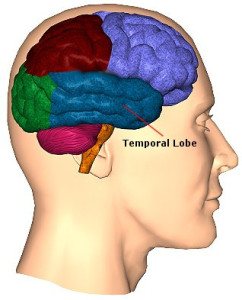
The temporal lobes contain a large number of substructures.
Functions of the Temporal Lobes
- Recognition of faces and objects
- Perception (hearing, vision, smell)
- Understanding language and emotional reactions
- Learning and memory
- Associated cognitive disorders
- Schizophrenia is the cognitive disorder most closely aligned to temporal lobe dysfunction.
Symptoms associated with head injury or tumours affecting the Temporal Lobes
- Prosopagnosia – difficulty recognising faces and names
- Difficulty in understanding speech
- Difficulty in identifying objects
- Hard to verbalise information about objects
- Short-term memory loss
- Aggressive behaviours
- Change in sexual interest
- Concentration difficulties
- Damage to right temporal lobe can result in incessant talking
- Right side lesion may affect rhythm and musicality
- Religiosity
- Seizure disorders
- Strange auras and reveries
- Disorders of visual perception
- Left side lesion – impaired verbal memory
- Right side lesion – impaired non-verbal memory
- Agnosias (refer to the inability to recognise specific categories e.g. body parts, colours, faces, music, smells)
|
|
Cerebellum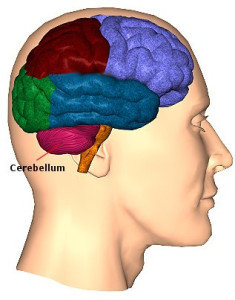
The cerebellum monitors and regulates motor behaviour, particularly automatic movements. Recent studies have associated the cerebellum with cognitive functions, such as learning and attention. Although the cerebellum accounts for roughly 10% of total brain weight, it contains more neurons than the rest of the brain combined. The cerebellum is also one of the few mammalian brain structures where adult neurogenesis (the development of new neurons) has been confirmed.
Functions of the Cerebellum
- coordination of voluntary movement
- motor–learning
- balance
- reflex memory
- posture
- timing
- sequence learning
Symptoms of associated with head injury or tumours affecting the Cerebellum include:
- Problems with balance and coordination
- Problems with co-ordination of limbs
- Intention tremor
- Abnormal eye movements – ‘nystagmus’
- Nausea and dizziness
|
|
Brain Stem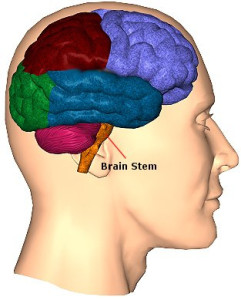
The brain stem consists of a group of structures that lie deep within the brain, including the Pons, medulla oblongata, and midbrain. It plays an important role in maintaining homeostasis by controlling autonomic functions such as breathing, heart rate and blood pressure. While the brain stem can organise motor movements such as reflexes, it coordinates with the motor cortex and associated areas to contribute to fine movements of limbs and the face.
Functions of the Cerebellum
- controlling autonomic functions (including blood pressure, breathing, digestion, heart rate, perspiration and temperature)
- alertness
- sleep
- balance
- startle response
- Associated cognitive disorders
Very few cognitive disorders have been associated with the brain stem.
Symptoms of associated with head injury or tumours affecting the Brain Stem include:
- double vision
- nausea
- sleepiness
- weakness on one side of the body.
However, because so many nerves go through the brain stem, problems here can cause a wide range of symptoms.
(With thanks to Dr Allison Lamont, BTBuddies.co.uk and Life Science Databases(LSDB). – from Anatomography, a website maintained by Life Science Databases (LSDB) for the image of the Hippocampus.)
Want to read more about the brain? Take the Brain Tour, test your knowledge with the Brain Quiz, find out Why your Brain needs Protein and how Jazz Brains are Different.
Any questions and experiences to share? Do leave us a comment here. |
